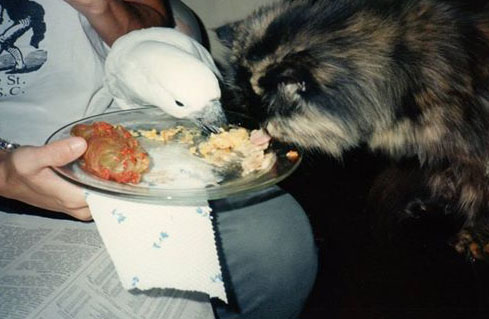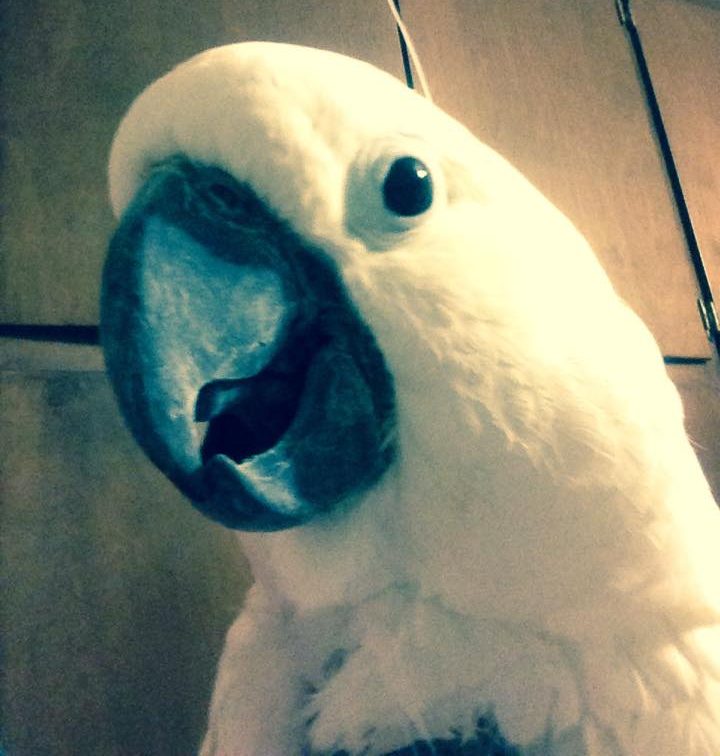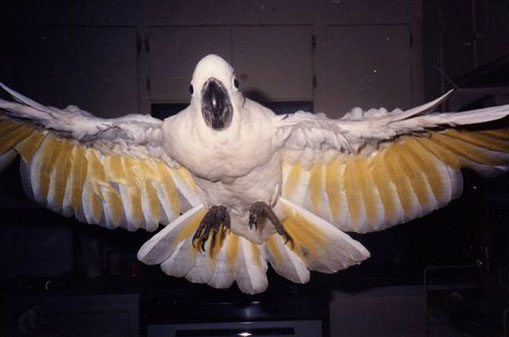He was supposed to live 70 years. Instead, as he traveled to his forever home in paradise, a series of mistakes and, ultimately, negligence killed him.
When I was about 11 years old, my family adopted an umbrella cockatoo. Instead of resembling the mighty white birds with towering head crests soaring through the forests of Indonesia, though, he was skinny, trembling, and rather naked when I first laid eyes on him.
His pale grey torso reminded me of a turkey corpse, plucked bare before Thanksgiving dinner. But he had inflicted this damage all on his own. Before my family took him in, his first guardian, who’d had him since he first hatched, gave birth to a human child, who soon consumed all her attention. The bird was often relegated to his cage, and there, languishing in boredom and isolation, he grew neurotic and angry, quite possibly jealous of the newborn stealing away all his mom’s affection.
So this bird turned on his own flesh, plucking feathers from his chest and dancing anxiously to and fro just to release some energy.
Such behavior is all too common in the captive population of parrots worldwide. Because of captive breeding and the illegal wildlife trade, tens of millions of parrots now occupy US homes and facilities–and thousands of them end up homeless every year as they become too rambunctious and under-stimulated in a caged environment or they outlive their human caretakers.
This particular cockatoo was one such bird–but, fortunately, my mom was ready and willing to jump to his rescue.
He came into our home with the name Lilah. But at the first vet visit, we learned that Lilah was indeed a he, not a she. Yet the name remained, as it was the primary tool from the English language he’d clung to for communication with our species. We couldn’t take that from him.
“Lilah?” he’d often ask in a quivering voice, as though pleading for food, affection, anything at all.
And those things, he soon learned, he would receive in abundance. At the offset, he became my cuddlebug. We were, more or less, around the same age. As an only child, I began to see him as a bit of a younger, talkative brother–like a toddler, first learning about the world and expressing his thoughts via a series of babbles and chuckles.

One evening, I approached his cage wearing a bright red tank top and reached in for some snuggle time, as I had done dozens of times before. But this time was different. This time, he rewarded me with a sharp, deep bite to my finger. Blood immediately pooled, and I wailed in response and ran away.
At that time, I was a loud, boisterous preteen with an opinion about everything. And the vivid red hue of my shirt was like a blaring “danger” sign. I’d scared him, and he reacted the only way he knew how.
But the incident scarred me enough to keep a healthy distance from him from then forward. And in my sulky teenage years, I found myself increasingly annoyed by his calls and shrieks, natural vocalizations that are used freely by flocks of wild parrots inhabiting the jungle, but are often found to be a nuisance by those attempting to confine these exuberant birds indoors.
I’ve always loved animals, but with Lilah, I could only love him from afar.
My mom, though, never wavered in her bond with him. Despite the handful of times he’d hauled off and pierced her nose with his beak upon being frightened by a man in a baseball cap or the vacuum cleaner, she adored him.
So, naturally, as my parents planned their big move to the Big Island of Hawaii in 2014, Lilah was coming with them. My mom plotted out the magnificent habitat she’d build for him in paradise, where he could soak in the sunlight, watch the flittering yellow finches, and eat exotic tropical fruits for decades to come.
But Lilah never made it there.
Hawaii has a host of complex requirements for importing animals, and birds specifically, to prevent the spread of disease–and my mom mastered them backwards and forwards.
A quarantine for 7 days at our local vet and a mountain of paperwork: check.
As my parents prepared to depart, leaving their two dogs and Lilah at the animal intake area of the airport, I bid farewell to the bird who’d once felt a little like my nemesis during my darkest periods of teenage angst, but now, cowering in his carrier, was like a fearful little child once again.
I didn’t know then that it would be our final goodbye, but it felt peaceful, like a long-awaited truce.
“I love you,” I said.
“Lilah?” he replied.
Later that night, my mom called me from California. Unfortunately, the vet had incorrectly completed the quarantine paperwork necessary for Lilah to enter Hawaii, so he had to redo his 7-day quarantine at a vet there. My parents opted to continue on to the islands with their two dogs and pay an animal transport company a hefty sum of money to handle Lilah’s trip a week later.
He would be in good hands, they were promised. He’d be given the utmost care.
A week later, I received another call.
“Laura, Lilah’s dying. He’s dying!” My mom’s blubbering voice could hardly make out the words.
He was in her lap, having just been picked up from the airport, and was listless, lethargic, barely hanging on.
“Can’t you find an emergency vet?” I begged over the phone.
But they were in the middle of nowhere, miles and miles from anyone who could help. He died there, in her lap, moments later, after suffering a seizure.

To this day, my mom has trouble speaking about this tragedy. The sadness, the overwhelming guilt of putting her beloved companion in the hands of someone who was supposed to provide for his safety. I know it so well–I’ve been there myself.
But what happened was a string of errors my mom never could have anticipated or prevented, starting with the vet’s quarantine paperwork, which led to another crucial error: the animal transporter, who was paid to see Lilah directly onto his inter-island flight between Honolulu (the only port of entry for animals) and Kona on the Big Island.
Instead, to save money, she’d checked him into a cargo flight and left him there, where he sat for hours without water or food before being boarded up. Then, the transporter went dark, failing to answer my mom’s texts or calls. My parents didn’t even know his flight number. They had nothing.
Thus, when Lilah arrived in the cargo hold of the Kona airport, my parents had no idea of his whereabouts and couldn’t reach anyone who knew anything at all.
By the time my mom was finally contacted to pick him up, he’d gone over 24 hours without water–and likely without being checked on at all. That neglect, compounded by the stress of flying cargo, ultimately killed him.
And so my family was left to grieve in their paradise, Lilah’s empty cage on their front porch a forever reminder of what could have been.
Flying animals in cargo is always risky. Every year, animal companions die. In 2018, a report revealed that there had been 85 animal deaths in the last 3 years on flights in the US, with nearly half occurring on United Airlines. And just a few weeks ago, in the wake of two cats’ deaths on a Russian airline, guardians took to social media with photos of their dogs and cats to tell the airline that animals aren’t cargo–they’re passengers–in hopes of changing in-flight policy.
As for Hawaii, the state requires that all animals coming into the islands be taken immediately to the quarantine holding facility in Honolulu for inspection–but it doesn’t prescribe how these animals must enter, which is up to the individual airlines. While many of them will allow companions to fly in-cabin between islands, only a couple allow this for flights from the mainland to the state, leaving thousands of cherished companions relegated to the cargo hold. Or, even worse, they’re put onto a cargo-only airline that deals mostly with inanimate shipments, leaving actual live animals with very little to no care or oversight.
Why? Because the logistics of ensuring that animals flying in-cabin make it over to the quarantine hold facility for inspection would take time. And time is money.
It’s been over five years, but it’s time for Lilah’s story to become more than a black cloud over my family. It’s time for me to share it with the world and help other dogs, cats, and birds from suffering the same fate.
It’s time for the major airlines from the mainland U.S. to the Hawaiian Islands to apply, at a bare minimum, the same rules they use for flights within the lower 48 states–which allow small animals in carriers to stay in the cabin with their families.
And for animals who are only given the option to travel in cargo either into or between the islands, these carriers must implement rigid standards for animal companions, including constant tracking of animals’ whereabouts, hourly monitoring in holding facilities, and provision of water at regular intervals.
Please join me in calling on these airlines to protect our beloved animals who are entrusted into their care by signing my petition below.
Petition to be delivered to: Hawaiian Airlines, Alaska Airlines, American Airlines, United Airlines, Delta Airlines, and Aloha Air Cargo.


This unexcuseable! Animals are NOT Cargo!!! Why would anyone let there loved ones be put there like luggage! Come on people!🤬🤬🤬🤬😭😭😭😭😭
The owners need to take responsibility for their ignorance. No pet should ever be left without food and water. There are feeders and water bottles that can be secured in carriers. I know because I had them for my parrots transporters.
I think in mentioning the regret and shame my mom feels every day of her life, I have made it evident that she is taking responsibility for her choices she made here. But she should not be doomed to live her life endlessly punishing herself. There are other external factors that played a major role here, and are fixable. We cannot change the actions my family took, but can demand better from companies that handle these animals in the future.
What a tragedy. Likah would have lived a long life.. but it was stolen from
Him by incompetent and uncaring people! Make sure your precious animals do not fly in the cargo hold.
Terrible, neglect on all persons. Food and drink for the bird, and wasn’t checked, why are animals in cargo with luggage?
Signed.
I hope that his tragic story serves as a warning for others in similar situations.
Sorry for your loss. It’s definitely overdue for airlines to treat animals with more respect. United Airlines not only kills animals, but loses them frequently.
I am so sorry for your personal loss and the suffering it caused for all of you these are our friends and family not cargo !
This speciesism needs to stop
Unfortunately, big business needs reminding that our pets are as important as all our loved ones….people are getting sick and tired of hearing about another senseless death of an animal on an airline! If they were smart they could make a fortune for being a caring safe mode of transportation for pets.
Your story breaks my heart and hits close to home. It has been my wish and dream to move to Maui with my husband and birds in the next 5 years but it is scary. I can’t imagine the sadness. I hope that airlines come to realize that birds are passengers too. 😢
I would never do that to my cockatiel lefty or my guiena pigs Rosa Lucy Ricky and fred the airlines need to improve the travel conditions for animals Vickie bell
I am so sorry to hear this story of your mom’s bird Lilah. We had a yellow naped Amazon for 29 years and we didn’t know she,had developed a heart condition until the end of her life. When our bird died my husband and I grieved more than we thought we would. Everyday became a day without her hello or Nite, nite, or any of the other sounds she communicated to us. She was like the soundtrack of our lives and now it was silent. No more bird sounds that were so normal to us.
I know just how your mom feels so please tell her how sorry I am. We haven’t gotten a new bird yet but we are thinking of it but now that we are older we’ll never get another bird with such a long life span.
The loss of a companion really is a deep grief unlike anything else. I am so sorry for your loss.
I am sorry for your loss, it’s never easy to lose a bird, they’re such lovely creatures. You could always adopt another yellow naped Amazon who’s a little older in age, so don’t get all your hopes down 🙂
Breaks my heart I am so sorry, I lost my cockatoo of 18 years back in 2017, I am still grieving, I have taken classes & have a cockatoo in quarantine, when it comes out I’m going to visit, I pray this bird is the one father God has sent me…I will treat this next cockatoo like Royalty. Animals don’t go in cargo ..
##adoptdontshop…..
I am so sorry for your loss, as well. Thanks for your support!
so absolutely heartbreaking. airlines should know better there is no excuse for this.
It is surprisingly easy to make this or any animal into an emotional support animal that can ride next to you anywhere. This family was moving to Hawaii so certainly they had a couple hundred extra to get his emotional support license. Again this is all the owner’s fault and negligence they should have taken a cruise to Hawaii instead of flying.
Falsely turning an animal into an emotional support animal is fraud and is a big problem. As far as I know, there is only one cruise ship that will take animals to Hawaii and it is $5,000 per person. And if a family was assured that their animal would be safe and truly believed it, they wouldn’t have thought that they needed to pursue that option. It’s easy for you to blame them, but hindsight is always 20/20. Think about their grief and regret now, and try to find empathy before making a comment like this.